


xxxxxAs we have seen, after the assassination of the great Persian ruler Nadir Shah in 1747 (G2), the commander of his body guard was elected king of Afghanistan with the title Ahmad Shah Durrani. He united the country, but following his death in 1772 there were periods of civil war. Early in the 18th century the Russians began to expand towards Anistan, hoping for an outlet to the Indian Ocean, and the British were anxious to stop their advance. In 1839, after failing to win over the Afghan leader Dost Muhammad, the British invaded the country in support of a former leader, Shoja Shah, in order to gain control. They quickly took over the major cities, but their harsh rule was opposed by many tribesmen, and in November 1841 a revolt broke out in Kabul. British officials were murdered, a military detachment lost 300 men, and the garrison was completely surrounded. Eventually the garrison was granted safe conduct to India, but while crossing the narrow, snowbound passes to the border, the 4,500 troops and the 12,000 civilians (many of them women and children) were attacked and massacred. Later that year, by way of reprisal, the British invaded the country again, and took their revenge on Kabul, but unable to stay there in strength, they then returned to India. As we shall see, in 1878 (Vb), with the Russians getting ever closer to the Afghan border, the British launched another invasion and began the Second Anglo-
THE FIRST ANGLO-
Acknowledgements
Map (Afghanistan): from www.afghanland.com/history/muhammadzai. Dost Muhammad: date and artist unknown – Victoria and Albert Museum, London. Khyber: painting, date and artist unknown. Remnants of an Army: by the British military artist Elizabeth Thompson (later Lady Butler), (1846-
x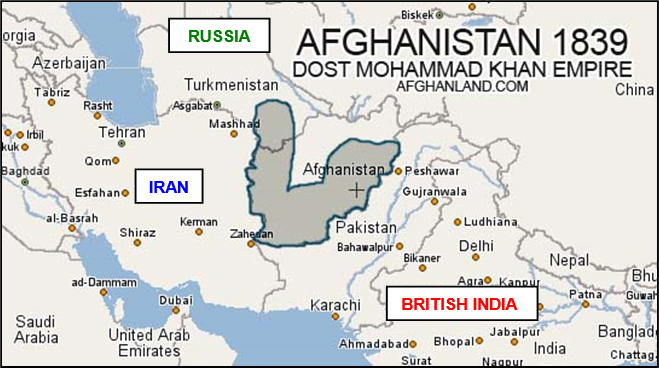 xxxxIt was during the rule of the Saffarids in the latter part of the 9th century that the Muslim faith was introduced into Afghanistan. The Mongol leader Genghis Khan invaded the country in 1219, but after his empire broke up, Afghanistan came divided between the Mughal Empire of India and the Safavid Empire of Persia (Iran). In 1738, however, the great Persian ruler Nadir Shah seized the whole of Afghanistan, and when he was assassinated in 1747 (G2), the commander of his body guard, Ahmad Khan Abdali, was elected king of Afghanistan with the title Ahmad Shah Durrani. Under his rule Afghanistan became a united country and remained so after his death in 1772, though frequently wracked by civil war and outside interference.
xxxxIt was during the rule of the Saffarids in the latter part of the 9th century that the Muslim faith was introduced into Afghanistan. The Mongol leader Genghis Khan invaded the country in 1219, but after his empire broke up, Afghanistan came divided between the Mughal Empire of India and the Safavid Empire of Persia (Iran). In 1738, however, the great Persian ruler Nadir Shah seized the whole of Afghanistan, and when he was assassinated in 1747 (G2), the commander of his body guard, Ahmad Khan Abdali, was elected king of Afghanistan with the title Ahmad Shah Durrani. Under his rule Afghanistan became a united country and remained so after his death in 1772, though frequently wracked by civil war and outside interference.
xxxxxBy the turn of the century the British, alarmed at the advance of the Russians as they moved southwards from the Caucasus, began to show an increasing interest in Afghanistan. Known for many years as an invasion route into India -
xxxxxMattersxcame to a head in 1837. In that year, in collusion with the Russians, the Iranians (Persians) advanced on Herat. The British, deeply concerned at this development, demanded that the Afghan leader, Dost Muhammad, sever all relations with the Russians and Iranians, and expel Captain P. Vitkevich, a Russian “commercial” agent conveniently based in Kabul. After some hesitation, Dost Muhammad rejected such demands, and began to negotiate with Vitkevich. In response the British East India Company set out to depose Dost Muhammad and restore a former ruler, Shoja Shah, to his rightful throne. This was clearly intended to be a puppet government under British rule, but in an attempt to justify such action, in October 1838 Lord Auckland, governor general of India, issued the Simla Manifesto. This stated that in order to have a trustworthy ally on India’s western frontier, the British were anxious to support a legitimate Shoja government “against foreign interference and factious opposition”.
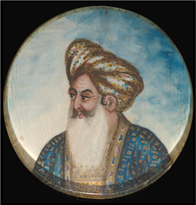
xxxxxThe opening campaign went well, despite the fact that Sikh assistance, promised by their leader Ranjit Singh, never materialised. An army of British and Indian troops took Kandahar without a fight in April 1839, and then three months later seized the fortress of Ghazni after a decisive victory. Having reached Kabul in June 1839, Shoja was enthroned in the August, and the following year Dost Muhammad (illustrated) was captured after the Battle of Parwan and exiled to India. Such was the success achieved, that by late 1840 the British felt able to withdraw some of their troops, though garrisons were set up in Kabul and other major centres, such as Jalalabad, Ghazni, and Kandahar.
xxxxxBut in a rugged land like Afghanistan, arriving there was one thing, staying there was quite another. There was no love lost for the occupying forces, especially after the reduction in tribal allowances. By October 1841 Afghan tribesmen were flocking to support Muhammad Akbar Khan (1816-
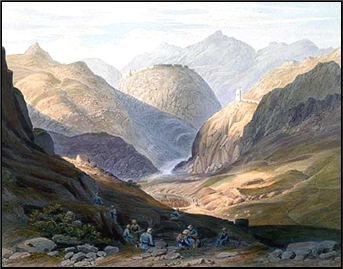 xxxxxIn retaliation, the British launched a second invasion later in 1842, this time with a larger Indian contingent. The garrison at Jalalabad was relieved, and then Kabul was recaptured, together with 95 prisoners. There the British destroyed the citadel, set fire to the great bazaar, and brutally put down any Afghan resistance, leaving 20,000 dead according to one estimate. By this time, however, the puppet leader Shoja Shah had been assassinated and his government overthrown. The possibility of occupying the country being out of the question, the British then withdrew to India via the Khyber Pass (illustrated) in October 1842. The war was over.
xxxxxIn retaliation, the British launched a second invasion later in 1842, this time with a larger Indian contingent. The garrison at Jalalabad was relieved, and then Kabul was recaptured, together with 95 prisoners. There the British destroyed the citadel, set fire to the great bazaar, and brutally put down any Afghan resistance, leaving 20,000 dead according to one estimate. By this time, however, the puppet leader Shoja Shah had been assassinated and his government overthrown. The possibility of occupying the country being out of the question, the British then withdrew to India via the Khyber Pass (illustrated) in October 1842. The war was over.
xxxxxThe First Afghan War was an humiliating defeat for the British East India Company, marked by the loss of the Kabul garrison, and the failure to gain any political influence in the country. In fact, the invasion served only to intensify the Afghans’ distrust and hatred of foreign interference. Furthermore, Russia’s growing interest in the country -
xxxxxIncidentally, the First Anglo-
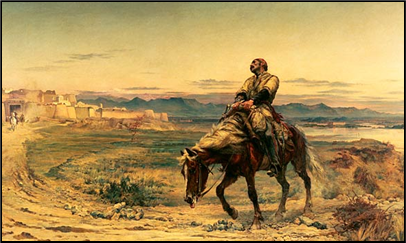
xxxxx…… Itxwas thought at first that Dr. William Brydon, an assistant surgeon with the Bengal Army, was the only member of the Kabul garrison to survive the massacre and reach Jalalabad. The moment of his arrival, totally exhausted and on a dying horse, was later captured by the Victorian military artist Elizabeth Thompson (1846-
xxxxxThree other wars, somewhat briefer in duration, also occurred on the northwest frontier of India during the 1840s. Thexfirst involved Sindh, an area covering much of the delta of the Indus (or Sindu) River. During the First Anglo-
xxxxxIncidentally, Napier’s younger brother General William Napier who, as we have seen, wrote an account of the Peninsular War in 1840, also wrote a History of the Conquest of Scinde five years later, based largely on the account of the conflict provided by his elder brother.
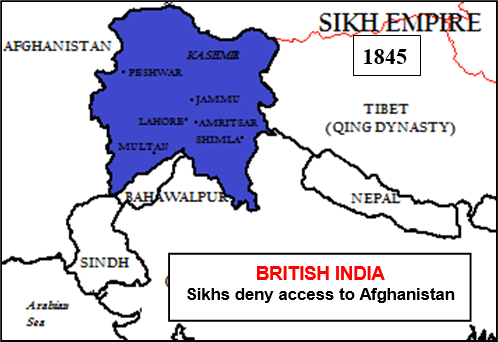 xxxxxIn 1845 came the First Sikh War. By this time Ranjit Singh, the founder of the Sikh state in the Punjab, was dead, and the country was firmly in the hands of military leaders. Having refused to allow British troops through their territory during the Anglo-
xxxxxIn 1845 came the First Sikh War. By this time Ranjit Singh, the founder of the Sikh state in the Punjab, was dead, and the country was firmly in the hands of military leaders. Having refused to allow British troops through their territory during the Anglo-
Including:
The Sindh and
The Sikh Wars

Va-


